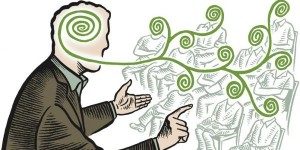
by Christophe Vorlet for The Chronicle.
Bravo! Bravo!
In this piece written by Dr. Alex Small for the Chronicle of Higher Education, he admits that he lectures in his classes. He also describes the ways in which he lectures. He doesn’t just stand in front of his class and speak AT his students. Instead, he states: “I break up the lecture with questions, discussions, and activities, and I try to shift much of the lower-level information delivery outside of class.”
Too often, lecture is equated with a one-way conversation streamed from expert to learner. We even say that our parents lecture us when we got in trouble as children. However, not all lectures look like that. I absolutely love the graphic (see above) that goes with this article, drawn by Christophe Vorlet representing that traditionally conceived notion of “lecture.” It could only be made better if it matched what Dr. Small said. Meaning, some lines are returning from the students to the teacher and some lines are moving between the students.
If you read my teaching philosophy, you will note that I’m a strong believer in constructivist, socio-constructivist, more learner-centered instruction and learning in the classroom. Usually, one believes that automatically rules out direct instruction and lecture by default, but it doesn’t have to, and sometimes it shouldn’t. More importantly, I believe in the power of deciding exactly what is needed in each context before deciding how to approach delivery, and it is often a mix of approaches that applies. No one wants to hear a 1 or 2 hour monologue. But it doesn’t have to look like that. Look at what Dr. Small describes:
Not every lecture is a person spending an hour talking nonstop to deliver facts. A good lecture is engaging, it naturally invites discussion and dialogue, it operates at a level much higher than raw information delivery, it is a natural setting for the expert to act as a role model, and it can be integrated with more formal activities (e.g., clicker questions, small-group discussions, etc.).
Lecture should not be the sole means of instruction, and bad lectures are a plague demanding eradication, but we err when we too strenuously inveigh against the lecture. ~ Alex Small.
I contend that a great teacher is one that analyzes the context of his/her situation (i.e., audience, lesson objectives, time, etc.) to determine the best course of action for teaching and learning. Dare I say it, but every once in a while that may mean using an approach that IS more aligned with behaviorist learning theories. And, wouldn’t that be appropriate if the objective is say, to memorize your multiplication facts. Now, a whole other argument could be made for the purpose and need of the objective, but too often K12 teachers don’t have a lot of autonomy in choosing objectives as they are dictated by the “powers that be” above their head–namely district personnel who are responding to state and national standards.
Like anything else, lectures have good points and bad points, and as Dr. Small says can be delivered in engaging, interactive ways when infused with other instructional/learning approaches. Simply put: Don’t diss the lecture. Consider it. Adapt it. Use it if appropriate.
Read Dr. Small’s words here: http://chronicle.com/article/In-Defense-of-the-Lecture/146797/?cid=at&utm_source=at&utm_medium=en